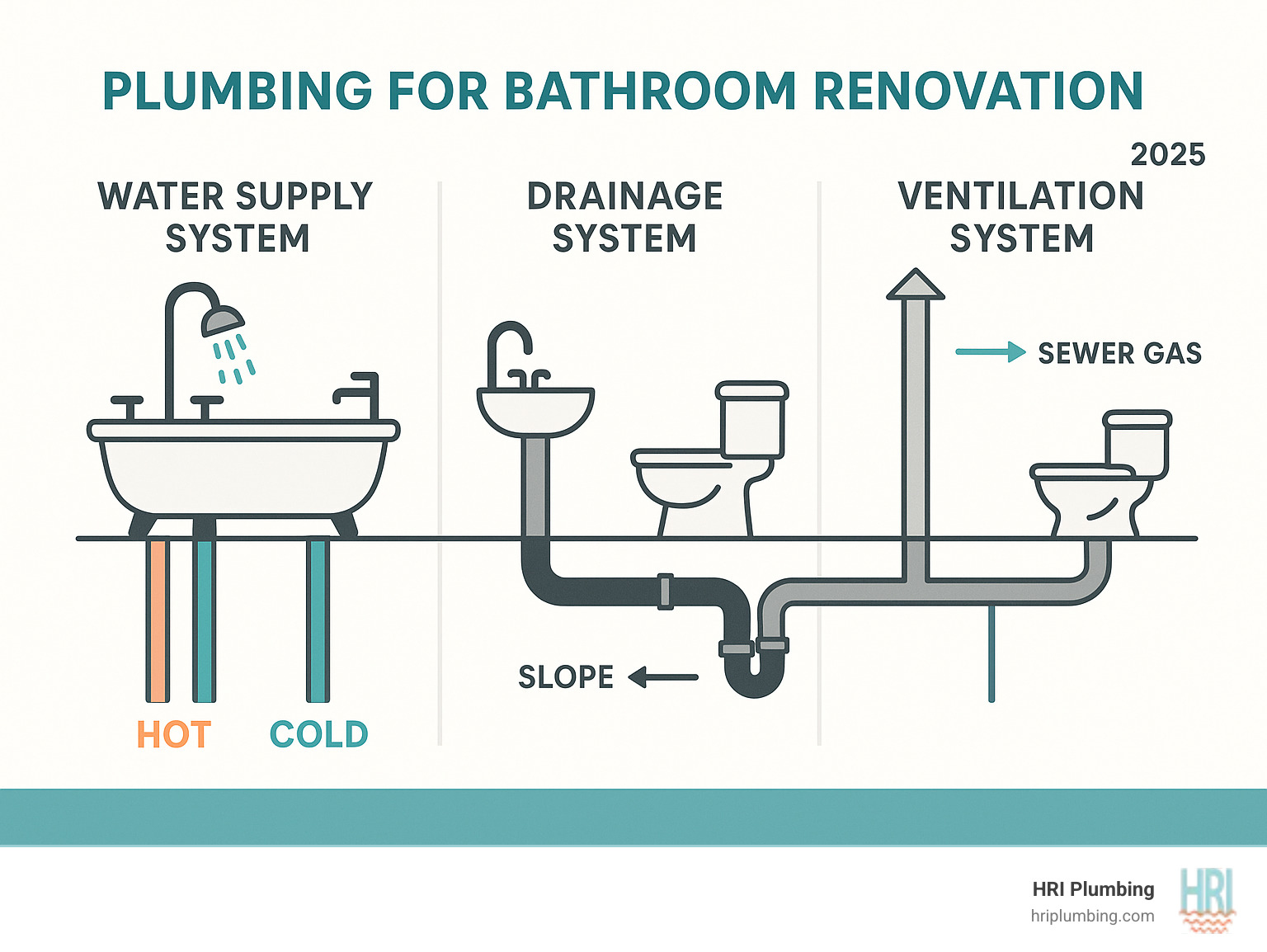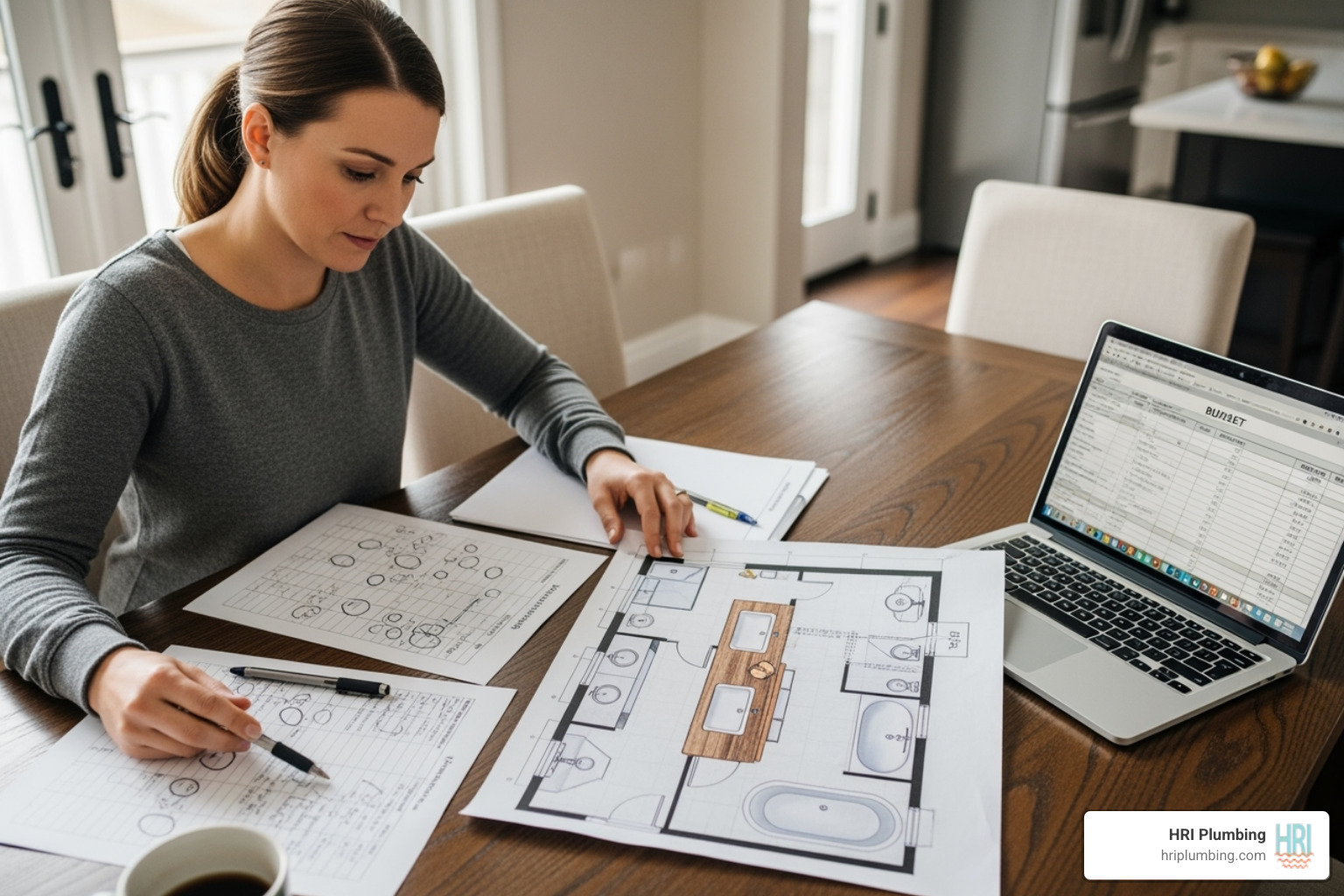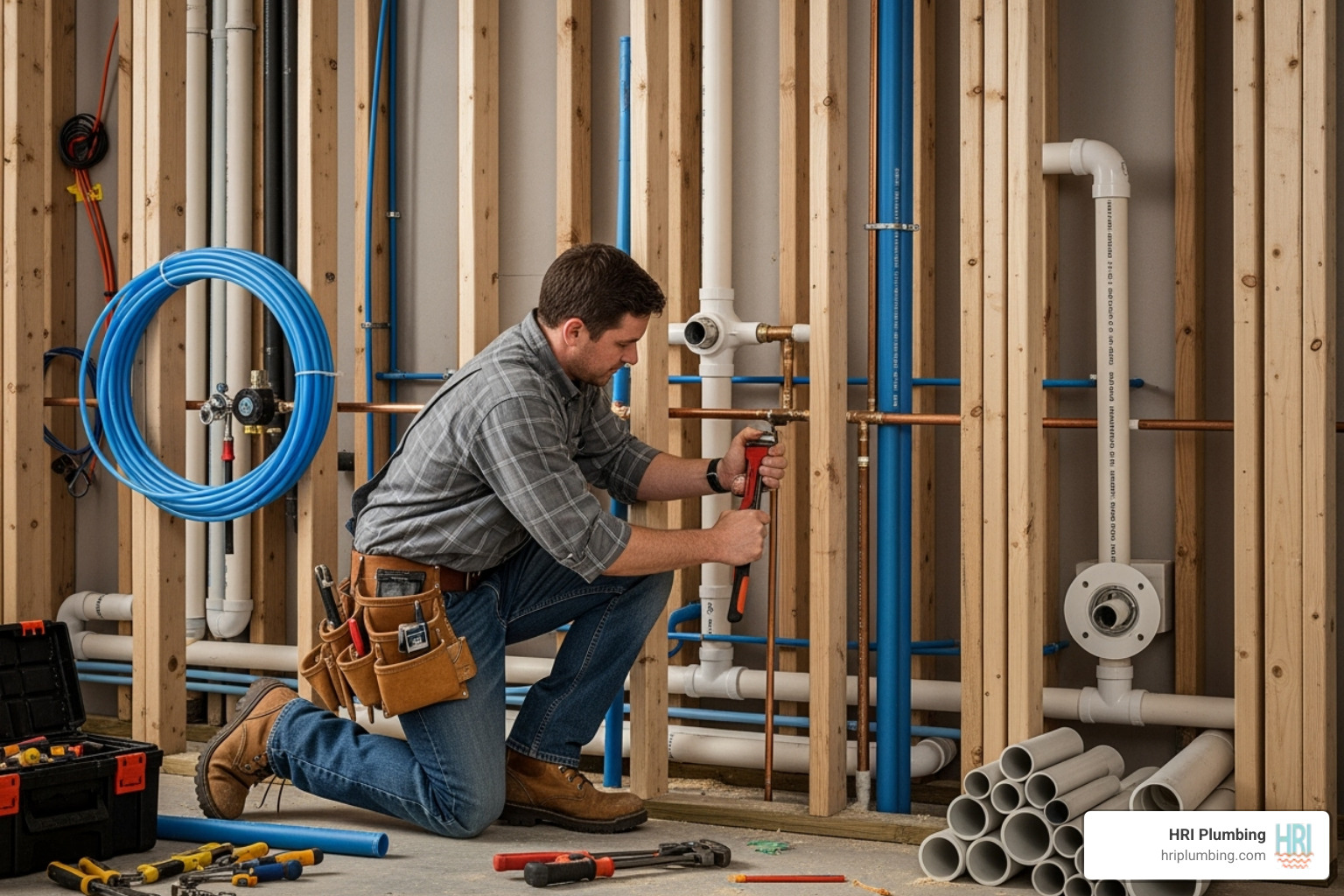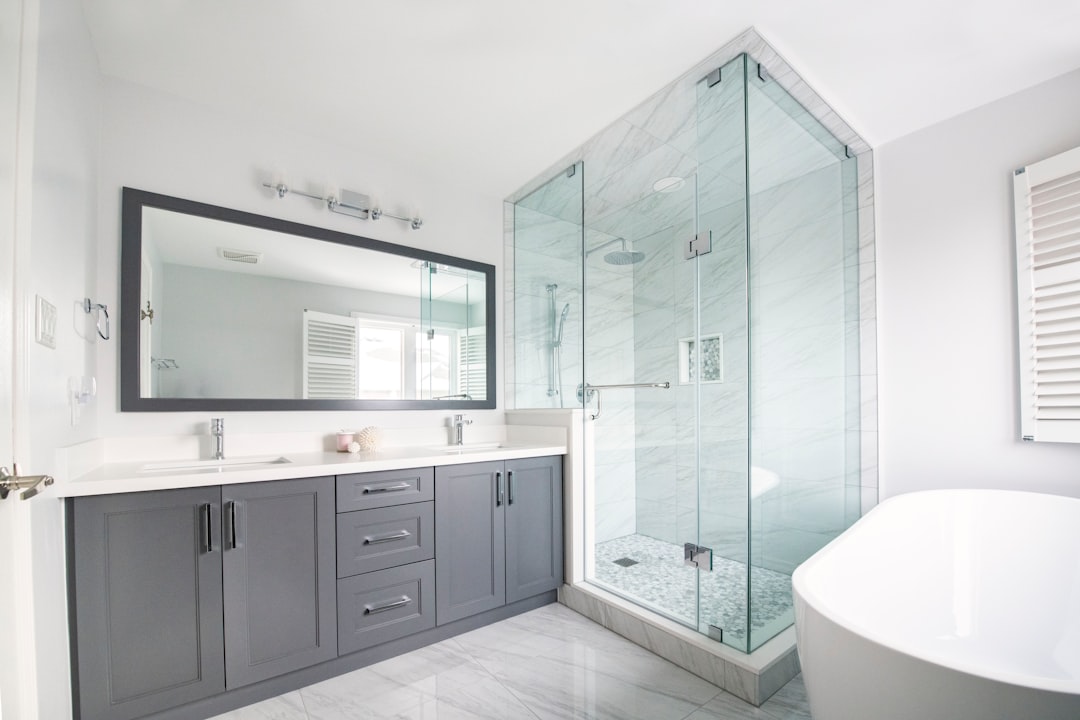Why Proper Plumbing Makes or Breaks Your Bathroom Renovation
A bathroom renovation is exciting, but the plumbing for bathroom renovation happening behind the walls is what truly makes everything function. Getting this foundation right from the start saves you from costly repairs and ensures your new fixtures work perfectly for years.
Essential plumbing components for bathroom renovation:
- Water supply lines: Hot and cold water pipes to all fixtures.
- Drainage systems: Waste removal from toilets, sinks, and showers.
- Ventilation: Proper venting to prevent sewer gases and ensure drainage.
- Fixture rough-ins: Precise placement for toilets, sinks, and showers.
- Code compliance: Meeting local building requirements and permits.
While plumbing costs can range from $2,900 to $8,700, with labor accounting for 40-50% of the budget, proper planning makes the investment worthwhile. Understanding the three critical plumbing systems—water supply, drainage, and ventilation—is the key to making informed decisions and avoiding expensive mistakes. Whether you're updating fixtures or completely reconfiguring your layout, a solid plan is your best tool for success.

Planning and Budgeting for Your Remodel's Plumbing

The secret to a successful bathroom renovation is smart planning and honest budgeting. Before you choose fixtures, define your goals for the space. Do you need more storage, a walk-in shower for aging in place, or a spa-like retreat? Your goals will guide the plumbing for bathroom renovation plan.
Planning the Plumbing for Bathroom Renovation
Fixture placement is critical and has specific rules. For example, a toilet needs about 15 inches from its center to any wall and 21 inches of clear space in front. To save money, try to keep new fixtures close to the original plumbing layout, as moving lines is complex and expensive.
Create a detailed plan by sketching your layout and measuring everything twice. When assessing your existing layout, check visible pipes and look behind access panels to see what you're working with. Understanding your water supply and drain lines is crucial for a system that flows smoothly. Finally, don't forget local building codes and permit requirements. A professional plumber ensures your project is safe and compliant, preventing issues when you sell your home.
More info about effective plumbing remodeling
Estimating Costs and Sticking to a Budget
Average plumbing costs for a bathroom remodel range from $2,900 to $8,700, but this depends on the project's scope. Labor costs are a significant factor, often making up 40-50% of the total plumbing budget.
Moving plumbing fixtures, especially toilets, will increase costs substantially due to the complexity of rerouting waste lines. To prepare for unexpected issues like corroded pipes or hidden water damage, always create a contingency fund of at least 10% of your total budget. If the numbers are daunting, financing options can help spread the cost over time.
Your project will require essential tools and materials, including safety gear, basic hand tools, and plumbing-specific tools like pipe cutters, plus pipes, fittings, and your new fixtures.
Key Plumbing Considerations for Your Bathroom Renovation

This is where your vision becomes reality. The core of this phase is "rough-in plumbing," where all water supply, drain, and vent lines are installed while the walls are open. It's the invisible foundation for your new fixtures, and precision is critical. Any mistakes at this stage are expensive to fix once the walls are closed.
During the rough-in, we also focus on proper drainage and ventilation, incorporate water efficiency upgrades, and address any outdated systems in older homes.
Choosing the Right Pipes: PEX vs. Copper
For your bathroom's water lines, you have two main options: PEX and copper. Both are excellent choices, but they have different strengths.
FeaturePEX PipingCopper PipingCostGenerally lower material costHigher material costFlexibilityHighly flexible, fewer fittings neededRigid, requires many fittings for turnsInstallation EaseVery easy for DIYers (no soldering/gluing)Requires soldering or specialized press toolsDurabilityLifespan of 40-50 years, resistant to scaleLifespan of 50+ years, durable, corrosion-resistantNoiseQuieter water flowCan sometimes produce "water hammer" noiseFreezingMore resistant to bursting from freezingSusceptible to bursting from freezing
PEX (cross-linked polyethylene) is a modern favorite due to its flexibility, which means fewer potential leak points. With a lifespan of 40-50 years, it's a durable and DIY-friendly option that doesn't require soldering.
Copper is the traditional, time-tested choice, lasting 50+ years. It's more expensive and requires professional soldering skills for installation, but its reliability is proven.
Information on replacing old piping
Installing New Fixtures: Toilets, Showers, and Sinks
Proper fixture installation requires precision. A shower valve must be positioned correctly during the rough-in, with the showerhead supply typically 80 inches from the floor. For toilet installation, the drain's center must be 12 inches from the finished wall, using a 3-inch PVC drain pipe and a new wax ring for a perfect seal.
For sinks, the drain should enter the wall 16 to 20 inches above the floor, with supply lines positioned nearby. Most sink drains use 1.5-inch PVC pipe. Consider installing water-efficient fixtures to save money and conserve water. Modern low-flow toilets with a high MaP (Maximum Performance) score (500+) offer efficient flushing without sacrificing performance.
Check toilet performance scoresProfessional toilet repair & installation services
Ensuring Proper Drainage and Ventilation
Proper drainage and ventilation are critical for a healthy, odor-free bathroom. Every drain pipe needs a minimum slope of 1/8 inch per foot to ensure wastewater flows away efficiently.
The vent stack, a vertical pipe running through the roof, allows air into the drainage system. This prevents dangerous sewer gases from entering your home and ensures water flows smoothly. Each fixture also needs a P-trap (a U-shaped pipe) to create a water barrier against these gases. Modern P-traps are superior to older S-traps. Finally, an exhaust fan that vents directly outside is your best defense against mold and mildew.
Common Challenges and How to Address Them

No plumbing for bathroom renovation is without surprises. Walls can hide problems, but preparing for common challenges helps you handle them without breaking your budget or your sanity.
Identifying and Fixing Hidden Issues
Demolition is your chance to play detective and find problems before they become disasters. Be on the lookout for these red flags:
- Musty smells: A clear sign of hidden moisture, leaks, or poor ventilation.
- Water damage: Look for soft or discolored subflooring and visible mold on drywall.
- Corroded pipes: Rust stains and mineral deposits are evidence of slow deterioration.
- Actively dripping pipes: These often hide behind walls, causing damage for years.
- Outdated wiring near plumbing: A serious safety hazard that requires immediate attention.
If you spot any of these signs, stop and investigate. Addressing them now saves you from major headaches later. Professional leak detection can be invaluable in these situations.
Navigating Obstacles in Older Homes
Older homes have charm, but their plumbing often needs significant updates to work with modern fixtures.
Common issues include:
- Galvanized and cast-iron pipes: These materials corrode over time, restricting water flow and causing leaks.
- Incompatible pipe sizes: Older pipes may not provide the water pressure and flow rates that new fixtures require.
- Poorly designed existing plumbing: Past DIY projects or outdated practices can lead to systems without proper venting or drainage.
- Structural obstacles: Floor joists or wall studs can be in the way of new pipe runs, requiring creative solutions.
Unexpected costs are common in older homes, which is why a contingency fund is essential. If widespread issues are found, a whole-home repipe is often the smartest long-term investment for a reliable, efficient plumbing system.
Comprehensive repiping services
DIY vs. Hiring a Pro: Making the Right Choice
For any plumbing for bathroom renovation, homeowners must decide whether to DIY or hire a professional. While DIY can save on labor costs, a small mistake can lead to thousands in water damage. The key is to honestly assess your skill level and know which tasks are safe to tackle and which require professional expertise.
Always prioritize safety precautions. Before starting any work, shut off the main water supply to your home and wear safety goggles and gloves.
DIY-Friendly Plumbing Tasks
For handy homeowners, some tasks are approachable and can save you money:
- Replacing a faucet: A straightforward task if existing supply lines are in good shape.
- Installing a new toilet: Manageable with careful attention to detail, especially when setting the wax ring for a perfect seal.
- Swapping a showerhead: Often the easiest upgrade, usually just requiring you to unscrew the old one and thread on the new one.
- Basic fixture connections: Connecting sink P-traps or supply lines can be a DIY job after a professional has completed the rough-in work.
When to Call a Professional Plumber
Some jobs are best left to professionals to ensure safety, compliance, and long-term value. Call a pro for:
- Moving supply or drain lines: This complex job requires rerouting pipes through walls and floors, demanding precise measurements and knowledge of drainage slopes and venting.
- Rough-in plumbing: This foundational work must be perfect before walls are closed. A pro ensures it passes inspection.
- Soldering copper pipes: This requires specialized tools and skills to create leak-free joints.
- Ensuring code compliance: Professionals are up-to-date on complex local plumbing codes, preventing costly tear-outs.
- Complex fixture installation: Large tubs or custom shower systems often require specialized knowledge and structural modifications.
The investment in a professional is often less expensive than repairing damage from a failed DIY attempt.
Why you should hire a pro to install your new toilet
Frequently Asked Questions about Bathroom Renovation Plumbing
We get many questions from homeowners starting on a plumbing for bathroom renovation. Here are answers to some of the most common ones we hear in the Springfield, Jacksonville, and Rushville areas.
How much does it cost to move plumbing in a bathroom?
Moving fixtures is often the most expensive part of a bathroom renovation. Costs are high because it involves rerouting both waste and supply lines through floors and walls. The waste pipe is especially tricky, as it requires a precise slope to drain properly. This complexity can push costs to the higher end of the average plumbing budget, sometimes exceeding $8,000, especially if it involves breaking through concrete.
Can a toilet and shower share the same drain?
No. While all fixtures eventually connect to the main drain stack, toilets and showers need separate secondary drain lines. Toilets carry "black water" (waste) and require a 3-inch drain, while showers carry "grey water" (soapy water) and use a 2-inch drain. Keeping them separate is crucial for hygiene, preventing cross-contamination, and ensuring proper drainage performance.
What are the first signs of a hidden plumbing problem during a remodel?
When you open up walls, be alert for red flags. The first sign is often a musty, persistent smell, indicating hidden moisture. Other visual clues include:
- Soft or discolored subflooring
- Visible mold or mildew on studs or drywall
- Corroded or actively dripping pipes
If you find any of these signs, stop work immediately and consult a professional. It's better to fix a hidden leak now than after your new tile is installed.
Signs of hidden leaks in your plumbing system
Ensure a Flawless Renovation with Expert Plumbing
We've covered the essentials for your plumbing for bathroom renovation, from initial planning to handling unexpected challenges. The key takeaway is that planning is everything. A detailed layout, a solid budget with a 10% contingency fund, and an understanding of your existing plumbing set the stage for success.
Proper drainage, ventilation, and material choices like PEX or copper are critical for long-term reliability. While some tasks like swapping a faucet are DIY-friendly, complex jobs like moving drain lines or completing rough-in plumbing require professional expertise. The value of a pro ensures your renovation not only looks great but functions perfectly and meets all local codes.
At HRI Plumbing, we've guided countless homeowners through bathroom renovations in Springfield and the surrounding areas. We know that behind every beautiful bathroom is solid, reliable plumbing that works quietly and efficiently.
Your dream bathroom is achievable. For a successful bathroom remodel in the Springfield, IL area, including Chatham, Rochester, Sherman, Rushville, and Jacksonville, trust our team to handle all your plumbing needs from start to finish. We'll make sure your renovation flows smoothly.
Contact us for your Springfield, IL bathroom remodeling project












